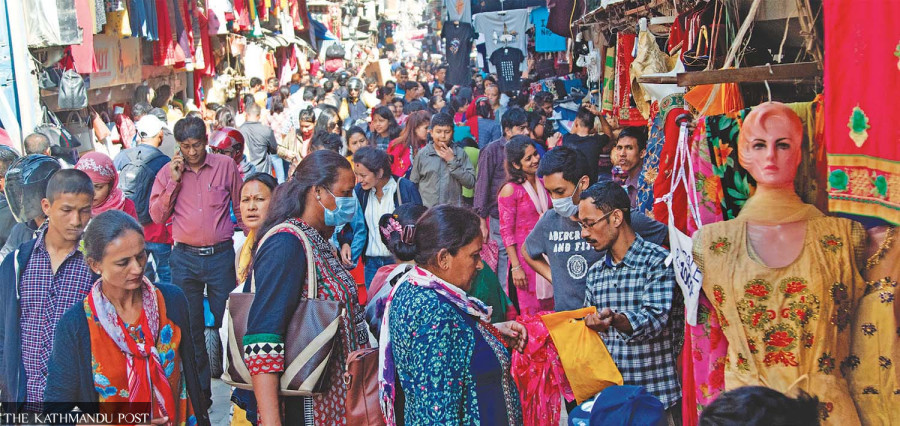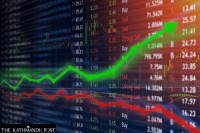Money
Ever-rising prices spoil Dashain shopping mood
The prices of food, clothes, footwear and electronic accessories could increase by 20-30 percent this Dashain, traders say.
Krishana Prasain
Kirtipur resident Ijan Jung Pandey says his tailoring business has rebounded to its former self after coming close to being ruined during the Covid-19 pandemic.
The coronavirus disaster is fading into the background, thankfully, and like Pandey, Nepalis are getting on with their lives.
But the jinx, it appears, has not left the country. No sooner had Pandey started easing into his familiar routine than another cause for anguish began spreading across the globe—inflation. Ever rising prices have brought suffering to millions since the beginning of the year.
Pandey, proprietor of Rastriya Poshak located on Shukrapath, has decided he will have to cut down on his festival spending this Dashain—everything is so expensive. He doesn't know what else he will do with market prices in a steep upward curve.
“Everything has become costlier,” said Pandey. “As we are a big family, Dashain expenditure usually comes to around Rs50,000. This year, even Rs80,000 will not be enough.”
People are pouring out onto the streets as the festival shopping season has started. But the mood in the market is gloomy because of the high prices that have put many goods beyond reach for many people.
From bullion to groceries, and garments to electronics, people only ask the prices but seldom buy anything, traders say.
Every year, the Dashain festival has been special to many Nepalis, particularly for the young, resulting in a massive shopping spree. This year, with no significant concerns about Covid-19, traders were expecting good sales.
But the Russia-Ukraine war and the high prices of petroleum products have made everything expensive.
As Covid is making a comeback in China, the world's largest producer of durable goods, it has affected consumers in many low-income countries like Nepal.
Consumer spending accounts for 90 percent of Nepal’s gross domestic product of Rs4.8 trillion, according to Nepal Rastra Bank.
This translates into a monthly consumption of Rs400 billion which swells in September and October during the festival season.
"The prices of clothes, footwear and electronic accessories could increase by 20-30 percent this Dashain," said Rajesh Manandhar, proprietor of Salt & Light, a women's clothing shop in Bouddha.
With Nepal’s trade through the northern border points coming to a standstill after China slammed the border shut due to a resurgence of the virus, traders are rerouting their shipments through the longer southern route, which means extra transport costs and ultimately higher price tags of goods.
The two crucial trade points of Tatopani and Rasuwagadhi on the northern border with China have been sealed since mid-August, damping the hopes of Nepali traders who have ordered goods worth billions for the festival shopping spree.
Manandhar, who has been importing clothes from China, said that the prices of shirts, pants, bags and footwear have increased by Rs200 to Rs300 apiece. “Prices will go up further. We don’t know by how much,” he added.
Dashain, the country’s biggest festival, is three weeks away which will be followed close behind by Tihar and Chhath. But the market mood is not optimistic.
“Banks and cooperatives are not issuing loans, and that has got traders worried too,” said Naresh Katuwal, immediate past president of the Nepal National Traders' Federation. "As the market may see a shortage of goods, prices will definitely increase."
The Nepali rupee has been in free fall against the dollar, with the result that dollar-denominated trade has ballooned.
In the last fiscal year ended mid-July, Nepal imported goods valued at nearly Rs2 trillion. Traders say that imports rose mainly due to global inflation. A stronger dollar added to the woes.
“The market outlook is gloomy. We expect festival sales to plummet by 50 percent this year due to the multiple factors like China’s trade restriction, fuel price hike and transportation costs,” said Ashok Kumar Shrestha, president of the Nepal Trans-Himalayan Border Commerce Association.
According to Shrestha, around 200 goods carriers loaded with festival goods headed for Nepal are stuck at the China border. “There is no sign of the re-opening of the northern border soon due to an increase in Covid-19 cases there.”
The government has also imposed import restrictions to stop the foreign exchange reserve from depleting further. Traders have to put 100 percent margin to open a letter of credit to import goods.
“We are not even getting loans due to the liquidity crisis in the banking sector,” said Shrestha. "Bank interest rates have also risen to such high levels."
Moreover, transportation costs have increased drastically. People are cutting their consumption budgets and that’s a worrying sign for the economy, economists say.
Food prices too are on the high side.
Pabitra Bajracharya, past president of the Nepal Retailers Association, said that the price of refined flour per 50-kg sack has increased by Rs1,000. It now costs Rs3,500.
The price has increased because India has restricted the export of wheat as it fears that the heat wave this year will cut food output, analysts say
"Wholesalers have increased the prices of sugar and rice," Bajracharya said. "Government market inspection teams should check the warehouses of big traders who import food items which will help in controlling prices in the market."
According to the World Bank’s Commodity Market Outlook, food prices rose by 84 percent, their largest increase in a comparable period since 2008. These increases in prices are having major humanitarian and economic impacts, and exacerbating food insecurity and inflation in many countries, the multilateral funding agency said.
Energy prices have increased sharply since the start of the year, with broad-based increases across all fuels; some coal and natural gas benchmarks reached all-time highs in March.
The war in Ukraine, supply chain disruptions, and the continued economic fallout of the Covid-19 pandemic are reversing years of development gains and pushing food prices to all-time highs.
Rising food prices have a greater impact on people in low- and middle-income countries since they spend a larger share of their income on food than people in high-income countries, the World Bank said.
In Nepal, the coming elections may further impact the market.
“With the election approaching, it will add reasons to increase the price for traders,” said Madhav Timalsina, president of the Consumer Rights Investigation Forum.
According to economists, the government has failed miserably to tame inflation.
Economist Bishwambher Pyakuryal told the Post in a recent interview that the election campaign will increase money flow in the market and increase government expenditure, which will make everything more expensive.
Nepal has scheduled federal and provincial elections for November 20.
The Inflation Expectations Survey report published by Nepal Rastra Bank recently says 94.7 percent of the survey respondents expected price levels to increase by 14 percent in the next three months.
Pyakuryal doubts the government’s official inflation rate of below 10 percent.
"As food traders are saying that India has increased the price of rice by IRs8 per kg and also restricted the export of food items, there seems to be a lack of coordination between the Ministry of Foreign Affairs and the Industry Ministry to address the issue," Timalsina said.
“The government should have a clear supply policy. The import ban on certain goods has prompted smuggling and an increase in prices. Market malpractices too have increased. Traders have been caught selling expired goods by relabelling the packages, and the government has not been able to control it," Timalsina said.
“This year, inflation has gone through the roof,” said Pandey. “The market is in distress.”




 9.12°C Kathmandu
9.12°C Kathmandu















